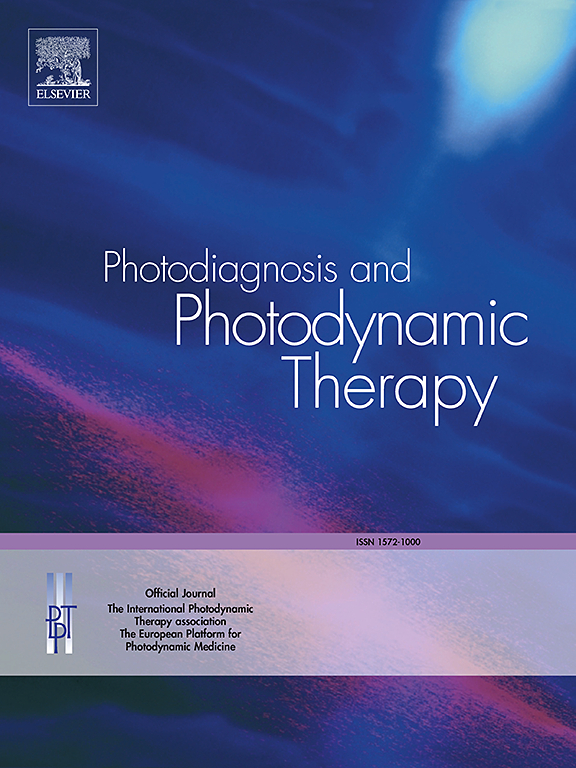PDT联合液氮冷冻治疗光化性角化病优于PDT单独治疗
IF 2.6
3区 医学
Q2 ONCOLOGY
引用次数: 0
摘要
背景:光化性角化病(AK)具有发展为鳞状细胞癌(SCC)的潜力。氨基乙酰丙酸光动力疗法(ALA-PDT)被认为是治疗AK的首选方法。为了提高临床清除率,通常采用PDT与其他治疗方法相结合的联合策略。本研究旨在评估冷冻治疗与PDT联合治疗AK的疗效和安全性。方法:在这项单中心研究中,66例经组织病理学和/或皮肤镜检查证实的光化性角化病患者入组。参与者被随机分为两组:一组接受液氮冷冻联合光动力治疗(LN-PDT),另一组接受对照光动力治疗(C-PDT),分别包括35名和31名患者。随访时间至少为6个月。在最终治疗后3个月和6个月系统地进行皮肤镜随访检查。主要结局指标是3个月时的初始完全清除率,而次要结局关注于6个月时的持续完全清除率。仔细记录两组患者的治疗效果和不良反应,并进行比较分析。结果:终末治疗后随访3个月,两组患者的初始完全清除率分别为93.6%和68.4%,差异有统计学意义(P <;0.05)。在6个月的随访中,两组的持续完全清除率分别为95.1%和72.6%,组间统计学差异也同样显著P <;0.05)。结论:对于光化性角化病(AK)病变,液氮冷冻联合光动力治疗比单独光动力治疗更有效。本文章由计算机程序翻译,如有差异,请以英文原文为准。
PDT combined with liquid nitrogen cryotherapy is superior to PDT alone in Actinic Keratosis
Background: Actinic keratosis (AK) possesses the potential to progress into squamous cell carcinoma (SCC). Aminolevulinic acid photodynamic therapy (ALA-PDT) is acknowledged as a preferred treatment modality for AK. To improve clinical clearance rates, combination strategies that integrate PDT with other therapeutic approaches are often utilized. This study seeks to assess the therapeutic efficacy and safety profile of combining cryotherapy with PDT in the management of AK. Methods: In this single-center study, 66 patients with histopathologically and/or dermatoscopically confirmed actinic keratosis were enrolled. Participants were randomly allocated into two groups: one receiving liquid nitrogen cryotherapy combined with photodynamic therapy (LN-PDT) and the other receiving control photodynamic therapy (C-PDT), comprising 35 and 31 patients, respectively. Follow-up was conducted for a minimum duration of 6 months. Dermoscopy follow-up examinations were systematically performed at 3-month and 6-month intervals post-final treatment. The primary outcome measure was the rate of initial complete clearance at the 3-month mark, whereas the secondary outcome focused on sustained complete clearance at 6 months. Treatment efficacy and adverse reaction profiles were meticulously documented and underwent comparative analysis between the two therapeutic groups. Results: At the 3-month follow-up post-final treatment, the initial complete clearance rates were 93.6 % and 68.4 % in the two respective groups, indicating a statistically significant difference (P < 0.05). At the 6-month follow-up, sustained complete clearance rates were 95.1 % and 72.6 % in the respective groups, with similarly significant intergroup statistical differences P < 0.05). Conclusion: For the treatment of actinic keratosis (AK) lesions, the combination of liquid nitrogen cryotherapy and photodynamic therapy was more therapeutically effective than photodynamic therapy alone.
求助全文
通过发布文献求助,成功后即可免费获取论文全文。
去求助
来源期刊

Photodiagnosis and Photodynamic Therapy
ONCOLOGY-
CiteScore
5.80
自引率
24.20%
发文量
509
审稿时长
50 days
期刊介绍:
Photodiagnosis and Photodynamic Therapy is an international journal for the dissemination of scientific knowledge and clinical developments of Photodiagnosis and Photodynamic Therapy in all medical specialties. The journal publishes original articles, review articles, case presentations, "how-to-do-it" articles, Letters to the Editor, short communications and relevant images with short descriptions. All submitted material is subject to a strict peer-review process.
 求助内容:
求助内容: 应助结果提醒方式:
应助结果提醒方式:


